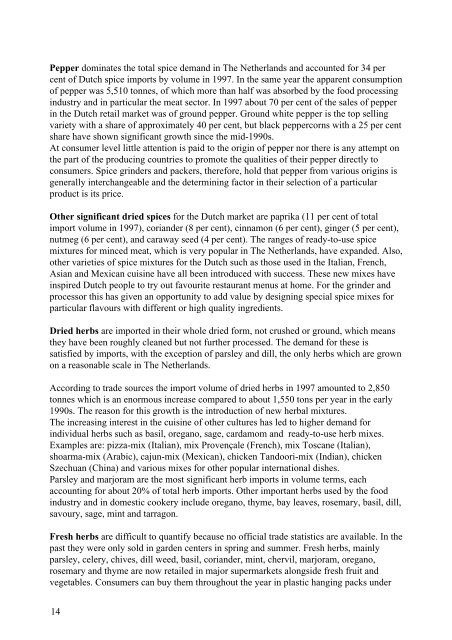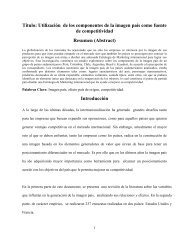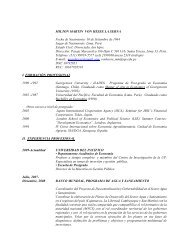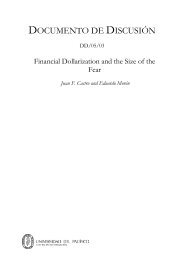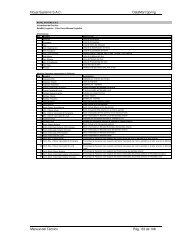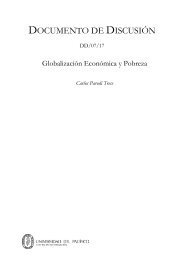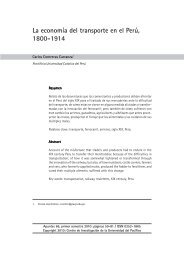Spices and Herbs
Spices and Herbs
Spices and Herbs
You also want an ePaper? Increase the reach of your titles
YUMPU automatically turns print PDFs into web optimized ePapers that Google loves.
Pepper dominates the total spice dem<strong>and</strong> in The Netherl<strong>and</strong>s <strong>and</strong> accounted for 34 per<br />
cent of Dutch spice imports by volume in 1997. In the same year the apparent consumption<br />
of pepper was 5,510 tonnes, of which more than half was absorbed by the food processing<br />
industry <strong>and</strong> in particular the meat sector. In 1997 about 70 per cent of the sales of pepper<br />
in the Dutch retail market was of ground pepper. Ground white pepper is the top selling<br />
variety with a share of approximately 40 per cent, but black peppercorns with a 25 per cent<br />
share have shown significant growth since the mid-1990s.<br />
At consumer level little attention is paid to the origin of pepper nor there is any attempt on<br />
the part of the producing countries to promote the qualities of their pepper directly to<br />
consumers. Spice grinders <strong>and</strong> packers, therefore, hold that pepper from various origins is<br />
generally interchangeable <strong>and</strong> the determining factor in their selection of a particular<br />
product is its price.<br />
Other significant dried spices for the Dutch market are paprika (11 per cent of total<br />
import volume in 1997), cori<strong>and</strong>er (8 per cent), cinnamon (6 per cent), ginger (5 per cent),<br />
nutmeg (6 per cent), <strong>and</strong> caraway seed (4 per cent). The ranges of ready-to-use spice<br />
mixtures for minced meat, which is very popular in The Netherl<strong>and</strong>s, have exp<strong>and</strong>ed. Also,<br />
other varieties of spice mixtures for the Dutch such as those used in the Italian, French,<br />
Asian <strong>and</strong> Mexican cuisine have all been introduced with success. These new mixes have<br />
inspired Dutch people to try out favourite restaurant menus at home. For the grinder <strong>and</strong><br />
processor this has given an opportunity to add value by designing special spice mixes for<br />
particular flavours with different or high quality ingredients.<br />
Dried herbs are imported in their whole dried form, not crushed or ground, which means<br />
they have been roughly cleaned but not further processed. The dem<strong>and</strong> for these is<br />
satisfied by imports, with the exception of parsley <strong>and</strong> dill, the only herbs which are grown<br />
on a reasonable scale in The Netherl<strong>and</strong>s.<br />
According to trade sources the import volume of dried herbs in 1997 amounted to 2,850<br />
tonnes which is an enormous increase compared to about 1,550 tons per year in the early<br />
1990s. The reason for this growth is the introduction of new herbal mixtures.<br />
The increasing interest in the cuisine of other cultures has led to higher dem<strong>and</strong> for<br />
individual herbs such as basil, oregano, sage, cardamom <strong>and</strong> ready-to-use herb mixes.<br />
Examples are: pizza-mix (Italian), mix Provençale (French), mix Toscane (Italian),<br />
shoarma-mix (Arabic), cajun-mix (Mexican), chicken T<strong>and</strong>oori-mix (Indian), chicken<br />
Szechuan (China) <strong>and</strong> various mixes for other popular international dishes.<br />
Parsley <strong>and</strong> marjoram are the most significant herb imports in volume terms, each<br />
accounting for about 20% of total herb imports. Other important herbs used by the food<br />
industry <strong>and</strong> in domestic cookery include oregano, thyme, bay leaves, rosemary, basil, dill,<br />
savoury, sage, mint <strong>and</strong> tarragon.<br />
Fresh herbs are difficult to quantify because no official trade statistics are available. In the<br />
past they were only sold in garden centers in spring <strong>and</strong> summer. Fresh herbs, mainly<br />
parsley, celery, chives, dill weed, basil, cori<strong>and</strong>er, mint, chervil, marjoram, oregano,<br />
rosemary <strong>and</strong> thyme are now retailed in major supermarkets alongside fresh fruit <strong>and</strong><br />
vegetables. Consumers can buy them throughout the year in plastic hanging packs under<br />
14


